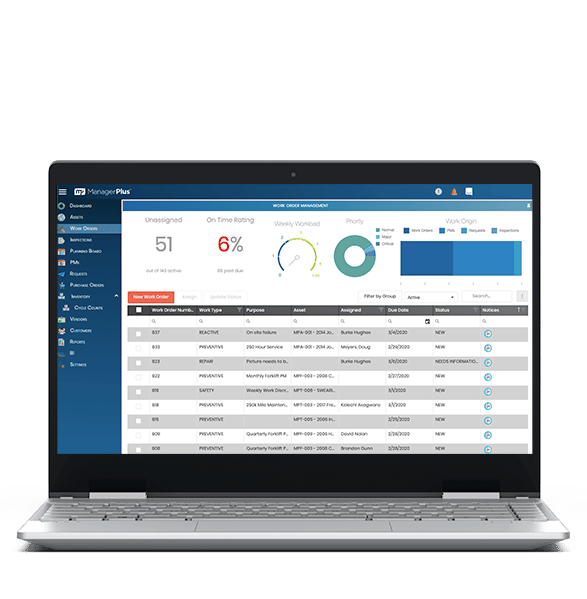The goal of any commercial building inspection is to make sure facilities remain in top form. From the roof to the lighting to the HVAC system, you’re charged with keeping a finger on the pulse of your establishment and the essential machines it houses. But… oversights can happen. If things fall through the cracks, your facility becomes ripe for an expensive inspection audit by regulatory authorities.
But here’s where you can bolster your process, leaving nothing to chance: the building inspection checklist.
Leveraging a robust checklist at the onset of your building inspection sets the stage for a comprehensive assessment of what’s working and what isn’t. It allows teams to find and document issues before any calamity would call your compliance status into question.
Let’s discover the specific ways a building inspection checklist can help you avoid having critical problems go unnoticed and undocumented.
What is a building inspection checklist?
The checklist you need will be an exhaustive list of each section of the commercial property you and your team are managing. It should include a clear overview of interior and exterior structures that may need repair or those that are nearing their expected lifespans. The checklist might include cost estimates for any repairs or replacements as well as root-cause analyses.
Ultimately, what you include plus any subsequent action items taken are an extension of how commercial building management teams determine return on investment over time. If there’s a structural failure or safety issues within the building that can be addressed early on, the company can stave off more costly fixes later. Preventive maintenance is key.

What do building inspectors look for?
As a facility manager, you’re fully engaged in the day-to-day; initiating work orders, ordering supplies, making sure operational efficiency consistently improves quarter over quarter. And building inspections? This is a big one for most maintenance providers. Building inspectors check for obvious problems like punctures or standing water on the roof, but they also look for structural problems around the property, such as cracks in concrete sidewalks or other paved surfaces.
Building inspectors also asses:
- Heating and cooling systems
- Interior elements, such as sheetrock
- Structural frame, such as the exterior and envelope
- Plumbing systems
- Electrical and other mechanical systems
- Fire safety violations
- Landscaping
- Maintenance and building plan records
- Surveys and cost assessments
These examples should serve as the basis for your checklist. But looking at issues through a “wide angle lens” will help you prevent even small problems from becoming massive headaches for you and your ops team. For example, if you know that HVAC systems will be assessed in an audit, take special care in reviewing the heat exchanger by using inspection mirrors. Look at the air distribution ducts. Take notice of the nitty gritty.
Remember, commercial building inspections focus on the structural integrity of the building, but can also include checking for evidence of unsafe environments, such as mold or water stains on the walls. These should be documented and handed off to your ops team to tackle the issues.
What is building inspection accountability?
For many, a clipboard and pen are the only tools available at the onset of a building inspection. For others, it’s a handy spreadsheet…that’s essentially tethered to a desktop computer. In either case, they don’t provide the essential and real-time data that teams need to quickly make repairs or to act in earnest on preventive maintenance issues. Enter ManagerPlus© Lightning, a facility management solution that closes the loop between operations and maintenance with mobile inspections. In plain English, you get accurate, up-to-date data on your plumbing systems, electrical, the interior and exterior surfaces of your complex, and more. The mobile app goes with you so you can quickly pull general or customized asset reports. It’s your building inspection checklist offering intelligence you can act upon in the now.
How can you fail a building inspection?
It is important that your building inspection checklist is constructed in a way that addresses all aspects of your building’s structure and utilities. Otherwise, it could result in a code violation and subsequent fines. The best way to get in front of any penalties is to be cognizant of what fails a building inspection. ManagerPlus Lightning empowers you to pinpoint red flags that help you be more proactive.
Let’s review a few scenarios.
When the HVAC system isn’t the right size
The machines in charge of cooling off the space will go haywire, turning on and off in order to regulate the temperature. This could lead to the complex being too hot or too cold or even lead to excessive humidity and mold growth. Bottom line, if the unit isn’t the right size, then it’s probably working too hard. From management’s perspective, the wrong-sized unit is a recipe for an unnecessary hike in electricity costs and a potential health hazard to workers. For the record, this would definitely make the cut for a failure on the building inspection report.
It’s also an opportunity to leverage ManagerPlus Lightning: assign a work order to your ops team for a replacement unit that’s appropriate for the space. It’s prudent to note that the old HVAC unit, which had been too small for the space, might have been installed by someone else in the distant past. But you can take ownership and accountability to ensure the new unit is up to specs now, and into the future.

When the circuits are overloaded
The tell-tale signs of overloaded circuits are pretty recognizable; flickering lights, a breaker that keeps shutting off the power, the smell of metal burning, and eerie buzzing noises from the outlets. It’s the circuit’s attempt at triggering your senses; a cry for help and a warning that a fire is imminent. Essentially, these visceral signals are in fact warnings that there’s too much electricity drawing from what the circuit can accommodate. And you guessed it — overloaded circuits can also fail an inspection.
What can you do to preempt a catastrophe in your building? Use the pre-populated failure codes in your software to quickly alert your ops team to make repairs quickly.
When backflow devices are missing
When part of your job is to ensure clean water gets into the building and waste water gets out, making sure a backflow device is installed is a huge priority. When the property is devoid of one of these devices, there’s a possibility of water contamination when there’s an unexpected drop in water pressure. This could be disastrous if left unaddressed.
ManagerPlus Lightning houses vendor information so you can reach out to get the proper utilities installed. Quickly pull general or customized asset reports to review any historical facts about these systems and make informed decisions on the fly.
What are the differences between commercial and residential facilities?
The biggest difference between commercial and residential building inspections is that residential checklist items are pretty standard across the board. Depending on your business, the points of inspection will vary. For example, while the improper venting of appliances may come into view for a restaurant chain, proper circuitry may be a point of inspection for a manufacturer.
Although many commercial inspectors voluntarily refer to the Standard Guide for Property Condition Assessments, a “baseline for property condition assessment,” each business type will have its own set of inspection criteria.
Then there’s the cost. For a homeowner, even the most egregious of defects could run them hundreds or thousands of dollars. For most commercial organizations, the cost could run in the tens or hundreds of thousands. Commercial business inspections are invested in the big picture – how much could the organization lose if this repair or replacement doesn’t take place by a given date?
The takeaway here is that teams working together to ascertain problems can do so more efficiently when they have a facility management solution available.
Next steps
Ready to take your business inspection checklist to the next level? Set up a call with one of our experts so you can share one-on-one the challenges your team is facing right now.
Summary
Your responsible for ensuring your facility is running smoothly and staying compliant. On top of all the headaches of a failed inspection there are all the associated costs, including the sometimes irreversible damage to your reputation. Checklists can help you, but only if you’re using them properly. Start by building them around where you already know inspectors always look. For example, your fire suppression systems. Then think about how you could fail. If you know where potential problems lie, you can better avoid them. If your team is struggling with paper- or spreadsheet-based checklists, it’s time to upgrade to a modern software solution that helps ensure the team is working with real-time data. There are costs connected to setting up a new system, but it all pays for itself by helping you avoid costly fines.
